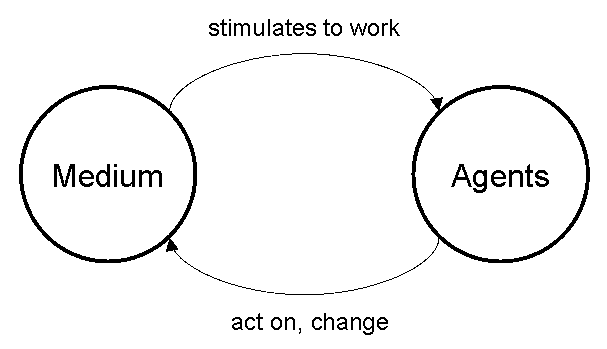Difference between revisions of "Stigmergy"
From Self-Organization Wiki
(→Concept) |
(→Important dimensions of stigmergy) |
||
| Line 8: | Line 8: | ||
==Important dimensions of stigmergy== | ==Important dimensions of stigmergy== | ||
* Lifetime/ Evaporation: how long does the trace last in the absence of further work? | * Lifetime/ Evaporation: how long does the trace last in the absence of further work? | ||
| − | ** defined evaporation for ant foraging: food sources get quickly exhausted, | + | Evaporation rate must be higher if valid information lifetime is short. |
| − | ** no evaporation for SO encyclopedia: | + | ** defined evaporation for ant foraging: food sources get quickly exhausted, and therefore the pheromone trace becomes outdated -> pheromones must evaporate quickly |
| + | ** no evaporation for SO encyclopedia: most articles have indefinite lifetime once they are "mature". | ||
| + | ** in-between applications might exist - eg. idea of newssystem where older information evaporates (so as not to overflow the front page). Notion of '''Frecency''' - recently and most frequently accessed articles. | ||
* Qualitative versus quantitative stigmergy | * Qualitative versus quantitative stigmergy | ||
** links in Wikipedia to non-exisiting articles | ** links in Wikipedia to non-exisiting articles | ||
| Line 15: | Line 17: | ||
* Local versus global memory | * Local versus global memory | ||
* Shortcomings of stigmergy | * Shortcomings of stigmergy | ||
| + | |||
| + | * Where does Stigmergy work well and where not? | ||
** Medium: You need a medium that is sufficiently stable (cannot use air as medium) | ** Medium: You need a medium that is sufficiently stable (cannot use air as medium) | ||
** Medium: Medium must be accessible by all agents | ** Medium: Medium must be accessible by all agents | ||
| − | ** Asynchronous nature (can also be an advantage) | + | ** Asynchronous nature (can also be an advantage) - you don't know when the next agent will come along - delay - timeliness not guaranteed |
| + | ** Anonymous communication - you don't know who the next agent is - implies a certain homogeneity of agents (one agent as good as the next eg. as in ants) or self-selection of agents (eg. only a person who thinks they are qualified will edit a Wikipedia article) | ||
** Reliability | ** Reliability | ||
* A list of applications would be needed | * A list of applications would be needed | ||
Revision as of 20:15, 29 July 2010
Presented by Francis Heylighen
Concept
The work of the agent(s) leaves a trace that is registered in the medium, where it is perceivable by other agents, stimulating them to further improve or extend the work that needs to be done. This is feedback cycle is mostly positive: more work being done leads to more further work being done. The feedback can be negative when an agent corrects or removes a mistake made by previous agent.
Important dimensions of stigmergy
- Lifetime/ Evaporation: how long does the trace last in the absence of further work?
Evaporation rate must be higher if valid information lifetime is short.
- defined evaporation for ant foraging: food sources get quickly exhausted, and therefore the pheromone trace becomes outdated -> pheromones must evaporate quickly
- no evaporation for SO encyclopedia: most articles have indefinite lifetime once they are "mature".
- in-between applications might exist - eg. idea of newssystem where older information evaporates (so as not to overflow the front page). Notion of Frecency - recently and most frequently accessed articles.
- Qualitative versus quantitative stigmergy
- links in Wikipedia to non-exisiting articles
- Number of agents
- Local versus global memory
- Shortcomings of stigmergy
- Where does Stigmergy work well and where not?
- Medium: You need a medium that is sufficiently stable (cannot use air as medium)
- Medium: Medium must be accessible by all agents
- Asynchronous nature (can also be an advantage) - you don't know when the next agent will come along - delay - timeliness not guaranteed
- Anonymous communication - you don't know who the next agent is - implies a certain homogeneity of agents (one agent as good as the next eg. as in ants) or self-selection of agents (eg. only a person who thinks they are qualified will edit a Wikipedia article)
- Reliability
- A list of applications would be needed
